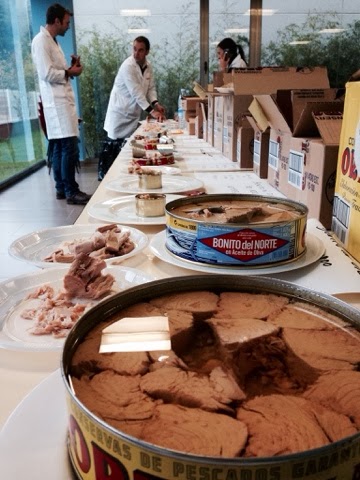Decades ago, chefs used to select their preferred tuna batches in person at Ortiz’s cannery, Spain’s highly esteemed fifth generation tinned fish titan. Batch tasting is still a common practice among cheesemongers; in fact, it’s a specialty of some exporters like Neal’s Yard Dairy and Essex Street Cheese, but for some reason it fell out of practice in the fish world.
Last fall I visited Spain to revive the tradition of selecting tinned fish.
We landed in Barcelona on a sunny November Sunday, a couple weeks after the six month tuna season had ended. It is a four hour drive northwest to Getaria, a small town on the Bay of Biscay, where the environment got progressively more Irish along the way: wetter, mistier, greener. Tasting was 9 am Monday and the first question on all of our minds—including the folks from Ortiz, who, being in their 30s and 40s, had never batch tasted either—was “Will we be able to taste a difference?”
That got answered quickly. The second tin we tasted was very different than the first. Revelations continued throughout the morning with some batches good, some excellent, and a couple extraordinary. Turns out, there is a big difference between batches of tinned fish, much like there is between batches of cheese, or wine vintages.
What constitutes a batch of tinned fish?
It’s a little more complicated than with cheese, where a batch is a single day’s make, usually a mix of the previous night’s and current morning’s milk. A tuna batch is a single catch from a single boat, brought in at one time and sold to one buyer. That’s how fish are managed in the Biscay auction market and Ortiz stays faithful to the one boat/one batch cooking. This means that the tin you get from Ortiz is traceable back to a single boat on a single catch (note: a catch may last longer than a day, but it always comes from a single shoal of fish). It may take several days to cook a big catch and, since the fish in it are different sizes and different ages, there’s bound to be more variability than with a single batch of cheese.
The main differences between tuna batches’ flavor are complexity, balance between sweetness and brine, and length. The best tunas had a range of high and low notes, were never just sweet or just salty, and have a long finish. Color foreshadows flavor: if a tuna is rosier, it is often better tasting. Texture plays a smaller part on just-tinned tuna, but over time it has a much bigger role. The older a tin of tuna in olive oil gets, the softer its mouthfeel becomes.
We decided on a single catch of bonito, caught in summer.
But before we made our final decision, we brought examples of nearly every tin we tasted back to Michigan so we could taste again later to confirm what we thought. A second round of tasting is one of those steps that I’ve learned, over time, is really important when I’m making a big flavor decision. Sometimes, out on the road where everything is more exciting, I can talk myself into liking something that, second time around, doesn’t live up to the hype.
The good news is that our batch passed with flying colors and we can enjoy it for most of the next year, at which time I’ll return to select again. I can hardly wait.

